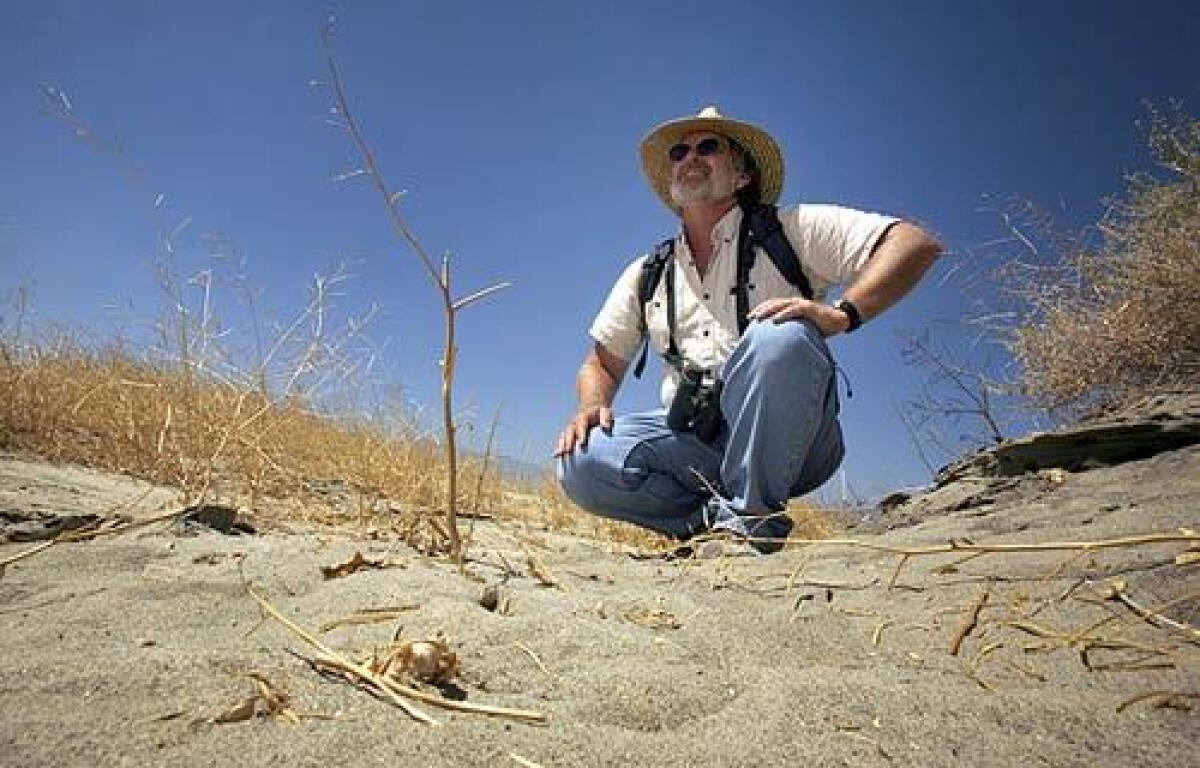Flat-tailed horned lizard is between a rock and extinction

- Share via
Reporting from Palm Springs — As the sun rose over a wind-swept stretch of desert just east of Palm Springs, Cameron Barrows tramped over a series of dunes, identifying animal tracks in the sand -- kangaroo rat, shovel-nosed snake, cottontail, pocket mouse, sidewinder rattlesnake.
FOR THE RECORD:
Endangered species: An article in Tuesday’s Section A about the legal battle to protect the flat-tailed horned lizard said the U.S. Fish and Wildlife Service had agreed to reconsider the Tehachapi slender salamander for listing as an endangered species. It is the first action the agency has taken on the salamander. —
It took nearly two hours to find what he was looking for in the desolate patch framed by Interstate 10, two golf courses, retirement homes, country clubs and stores: fresh tracks of a flat-tailed horned lizard, one of the rarest and most legally contested reptiles in the United States.
“This is the last corner in the Coachella Valley that still has a population of these lizards,” said Barrows, a research ecologist at UC Riverside and an expert on the secretive creature with a face that resembles the parched and thorny landscape it prefers. “Nearly all of its habitat in this region has been lost since 1970.”
In the latest chapter in a long-running battle to keep the lizard safe from urban encroachment, the U.S. 9th Circuit Court of Appeals recently ordered the U.S. Fish and Wildlife Service to reconsider its earlier decisions not to list it as an endangered species.
Environmentalists were elated by the ruling, which rejected a Bush administration policy they said favored development and corporate interests at the expense of the flat-tailed horned lizard and scores of other fragile plants and animals.
“This is the third time in 15 years since the lizard was first proposed for listing that a court has told the Fish and Wildlife Service to go back and review its refusal to protect it,” Kara Gillon, senior staff attorney with Defenders of Wildlife, said in a statement. “We’re hoping the third time is the charm. These lizards are running out of time.”
The flat-tailed horned lizard is only the latest creature in recent weeks to be reconsidered for special federal protection. In response to lawsuits and petitions, the U.S. Fish and Wildlife Service has also agreed to reconsider the Tehachapi slender salamander and critical habitat for the Sonoma County population of California tiger salamander.
Over the years, federal wildlife authorities insisted that the flat-tailed horned lizard was simply hard to find and, as a result, difficult to classify as threatened by extinction.
But biologists contend the lizard continues to decline throughout its historic range in Arizona, California and Baja California. In the Coachella Valley, it has been pushed into the tiny refuge by the growing desert metropolis that stretches from Palm Springs to the Salton Sea.
A century ago, the lizard was widespread and dynamic, moving east and west with changes in climate and the availability of sand in what was then a wide-open, treeless landscape. The first waves of significant habitat loss occurred in the 1930s, ‘40s and ‘50s as a result of a boom in agriculture.
Later, its historic haunts were fragmented and destroyed by roads, off-road vehicles, light industry, suburban tracts, condominiums and commercial centers. In the Palm Springs area -- the western edges of its range -- some populations were stranded by development and disappeared.
Today, the sole remnant of the population clings to existence in a pocket of dunes, creosote and salt bush within the Coachella Valley National Wildlife Refuge, where a new, unanticipated danger threatens its future. Power poles and exotic palm trees favored by landscapers have become perches used by small falcons to spot prey and launch hunting sorties.
As a result, “flat-tailed horned lizards are no longer found on the edges of their last habitat,” Barrows said. “I’ve suggested that the surrounding palm trees be trimmed in the spring to keep small predatory birds from nesting in them.”
Striding across a trio of dunes while scanning the ground for signs of the lizard, he said, “This animal is hard to find even in the best of times. So we count their tracks, which requires a lot of patience and training.”
A full day of searching on a recent Saturday yielded six tracks.
The lizard -- 3 1/2 inches long and a voracious consumer of harvester ants -- has been the focus of court battles since it was first proposed for listing in 1993.
Now, in response to legal challenges brought by a coalition of environmental groups -- the Tucson Herpetological Society, Defenders of Wildlife, the Center for Biological Diversity, the Horned Lizard Conservation Society and the Sierra Club -- the 9th Circuit Court has ordered the agency to think again about the lizard’s survival.
In the meantime, it shares the sun-scorched refuge with another unique and controversial representative of Coachella Valley desert life also threatened with extinction: the fringe-toed lizard, a small reptile with a patchwork of brick-like markings and feet shaped so it can “swim” through loose sand.
Judging from the number of tracks the lizards leave etched in the sand, there many more fringe-toed lizards.
“Will the flat-tailed horned lizard survive? We don’t know,” said Allan Muth, a plaintiff in the lawsuit and director of the Boyd Deep Canyon Desert Research Center, south of Palm Desert.
“Small, isolated populations tend to wink out. That’s why there is so much importance attached to this case.”
More to Read
Sign up for Essential California
The most important California stories and recommendations in your inbox every morning.
You may occasionally receive promotional content from the Los Angeles Times.











